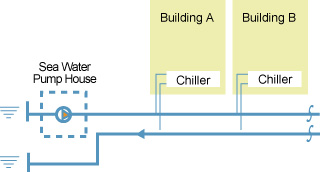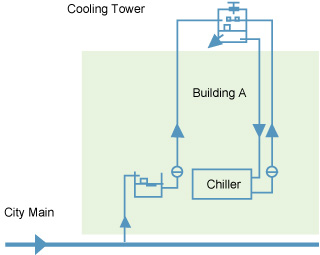BUILDING
Water-cooled Air-Conditioning System
The use of air conditioning takes a large proportion of total electricity consumption in Hong Kong, Air-conditioning systems attribute about 30% of the total electricity consumption in Hong Kong. With increasing population and development, the energy consumption of air conditioning systems will likely continue to grow continuously.
Cooling or heat rejection process of air-conditioning systems is based on thermodynamic principles and involved heat transfer between fluids. Heat generated from the process is released to the environment.
According to the different cooling medium of condenser, air-conditioning systems can be divided into two categories, namely air-cooled and water cooled system.
Currently, majority of the air-conditioning systems in non-domestic premises are electrical motor-driven centralized air-cooled type with fair energy efficiency. Water-cooled air-conditioning systems (WACS) are intrinsically have a higher COP (Coefficient of Performance) than air-cooled air-conditioning systems (AACS). So, conversion of AACS to WACS could therefore result considerable electricity saving.
Air-cooled systems are applied in small to medium centralized air-conditioning installations, where convenient and reliable water source is unavailable. It requires more electricity and larger heat exchange surface compared with the water-cooled systems.
In Hong Kong, the most widely adopted water-cooled air conditioning systems are the once-through water cooling system and the recirculating water cooling tower system.
Water-cooled by Seawater cooling

Once-through water cooling system is applied in large centralized air-conditioning installations in locations where sufficient cooling water is available, such as those along the seafront of Victoria Harbour. The once-through water cooling system uses seawater to take away heat of condenser and eventually discharge to the sea.
Water-cooled by cooling Tower

If seawater source is not available in close proximity of the air-conditioned premises and the permission of using fresh water for evaporative cooling towers in air-conditioning installations is obtained, the recirculating water cooling tower systems can be used in medium to large centralized air-conditioning installations. In the recirculating water cooling towers, cooling water is cooled when the water droplet is in contact with the air stream and small amount of cooling water is evaporated.
Water-cooled air-conditioning system using fresh water cooling towers are generally more energy-efficient, consuming up to 20% less electricity than air-cooled air-conditioning systems. Owners of non-domestic premises are encouraged to use fresh water cooling towers and to join EMSD’s Fresh Water Cooling Towers (FWCT) Scheme for their fresh water cooling towers installations.